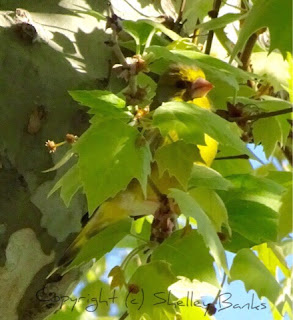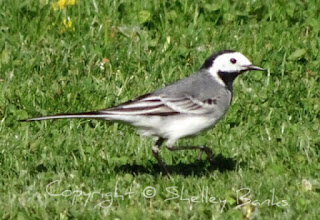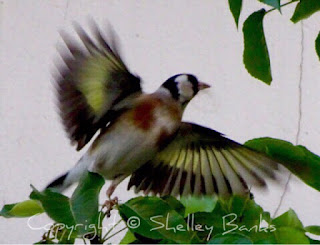Because it's almost Easter, a European Rabbit, eating a poppy petal beside Carcassonne's Cité, or walled castle town.
 |
| We saw this quite small rabbit along the edge of the castle walls. Here, it's eating a poppy petal. © SB |
As for the birds, Pigeons are the most abundant species of birds I've seen in Carcassonne, roosting in nooks and crannies of the old castle walls.
Next, the Great Tit, whose loud song can be heard along the River Aude, below the walled city. (I'm glad these birds are now posing more cooperatively for me here, than in Paris.)
There are also many flocks of sparrows. The ones below appear to be Eurasian Tree Sparrows, with their characteristic brown heads and black cheek spots. (In this species, males and females look the same.)
And, here is a pair of common House Sparrows:
Along the river, there were mainly Mallard ducks, though we saw a bright white duck that may have been a domestic breed, or -- from its curled tail feathers -- related to the Mallards...
And what would any water, much less the River Aude, be without a Herring Gull?
 |
| There are other similar gulls, but my guess is a Herring Gull. © SB |
Or a European Beaver? This large rodent looks like our North American beaver, though with a paler coat and narrower tail, but it is a completely different species, once hunted almost to extinction.
 |
| European Beaver, in the Aude River. © SB |
We walked through the old graveyard beside La Cité de Carcassonne, the old walled town, and saw a Greenfinch.
 |
| Greenfinch, from another angle.. © SB |
This bird below is also green, with a pinkish finch bill, and as that green belly colouring is typical, I think it's also a Greenfinch.
 |
| Greenfinch. © SB |
The next bird was also in the cemetery. From its heavily streaked sides and yellow chest and head, it looks like a (European) Serin to me, one of the smallest of the finches.
 |
| European Serin, a small finch. © SB |
Some birds dart, too, like the White or Pied Wagtail, which I remember seeing in Ireland, too.
Walking through a park beside the river one morning, I found a European Robin.
And, near the town laundromat, a European Goldfinch, collecting fibres for its nest.
The bright yellow flash of a goldfinch's wings — that's the source of this bird's name.
And black and white Common or House Martins have returned from their winter in Africa to their closed mud nests, tucked under the eaves and decorative cornices of many buildings here.
I've also seen and heard Starlings, and there are Jackdaws, too... And lots of new-to-me, unidentified birdsong...
###





















No comments:
Post a Comment